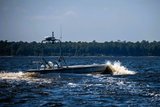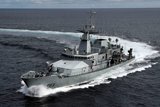Managing risk in a changing world: how the Royal Navy can win
Enjoy free access to this sponsored article, all content provided by Amentum
Amentum provides project, programme and enterprise management, advanced engineering, technology solutions, and mission support to enhance military readiness and national security in the USA, UK, Australia and elsewhere.
The Royal Navy oversees a wide-ranging enterprise covering a myriad of activity to enable its primary missions of deterring adversaries and protecting the nation. This includes maintaining and supporting platforms, together with upgrades and new-build projects and programmes to introduce fresh capabilities.
The Navy faces additional challenges from the rate of change in equipment, platform and battlefield requirements. This often outpaces support infrastructure and decision timescales and creates a mismatch of operational and financial aspirations, compounded by potentially optimistic initial cost estimates, which later lead to impacts on other key projects, programmes and operational activities.
Increasing operational demand is magnifying these impacts and causing increased stress on the structures and approaches used to manage the portfolio of activity.
Siloed cultures inhibit the effectiveness of leadership and engagement, leading to friction and wastage. Key individuals running projects and programmes are judged on criteria which do not always align with what is best for the enterprise as a whole.
Adopting approaches
However, the Navy’s challenges are not unique. Experiences and approaches which have been successfully adopted elsewhere could enable better visibility and management of these risks.
An example of this might be tracking the performance and business security of suppliers, who nominally sit outside the enterprise, but nevertheless provide key sub-components.
To illustrate this, the submarine shiplift at HM Naval Base Clyde used to rely on three-inch floppy disks, and there was a sudden realisation that the last manufacturer of these disks had stopped making them, so it rapidly became necessary to buy up all the available stock on the market to provide sufficient reserves whilst a new operator/user interface system was designed, approved and implemented.
Recognising such dependencies and threats to them – and so to critical infrastructure and systems – is essential but often requires tracing back through several levels of sub-component.

Another example is the requirement that the timber used as cappers in submarine dry dock support cradles should be from the slow-growing Douglas fir, of which there is a limited set of appropriate suppliers. With a single team looking across all the infrastructure requirements for the Dreadnought programme, it was recognised that there was a risk of not having sufficient timber at the right times if each project within the enterprise acted alone and without wider consideration.
Conversely, by taking a coordinated approach, the risk was mitigated and an opportunity realised to get a better overall price for the Navy.
Risk management – particularly at an enterprise level – requires brute effort, rigour and discipline; involving people with a broad, as well as deep, understanding of the enterprise (including key underpinning assumptions and their continuing validity), to identify the connections between activities and outcomes, and emergent changes, taking informed decisions on risks and how to mitigate them.
System-of-Systems Approach
To enable risk awareness, informed decision-making and effective portfolio management, we recommend using the Project 13 and Management of Portfolios frameworks and bespoke methodologies such as our System-of-Systems Approach (SoSA).
The Institution of Civil Engineers introduced the Project 13 delivery approach, which identifies five areas critical to enabling an integrated enterprise:
- Capable owner: The owner sits at the heart of the enterprise, not just as the owner of the assets, but also as the owner of the outcomes for the customers and/or users.
- Governance: There needs to be a shift in focus from price to value. Commercial arrangements and incentives will be aligned with customer outcomes and whole-life cost.
- Organisation: Enterprise organisations will increasingly be coalitions of partners and suppliers working with aligned commercial interests (aligned to the objectives of the enterprise) within a defined framework.
- Integration: An effective integrator will pull together the partner ecosystem to deliver the required outcomes. It entails integration across the end-to-end delivery process.
- Digital Information: Effective information management across the enterprise and throughout the delivery process will be a key enabler of success.
- The Management of Portfolios framework encourages uniform and coherent ways of delivering programmes and portfolios and offers a secure foundation for assurance, risk management and decision-making. It focuses on six key enterprise functions/activities: business as usual; strategic/business planning; budgeting and resource allocation; programme and project management; performance management; and corporate governance.
Amentum’s SoSA is designed to drive best-practice systems engineering to improve delivery of effective and affordable military capability. SoSA is a response to the challenges of increasingly complex capability design, acquisition and operating environments and majors on identifying and addressing dependencies.
In delivering SoSA tasks, Amentum provides a range of tools that improve communication and collaboration between the various independent organisations responsible for managing the acquisition of systems within the military environment.
One thing is clear: the Royal Navy should consider changing its approach to enterprise risk management to ensure it has the right level of planning, rigour, consistency and sophistication of process to keep on top of the increasing scale and complexity of the challenges ahead.
About the author - Martin Ewence, Maritime Domain Director, Amentum
During 33 years’ military experience on sea and land, Martin served in conflict zones from the South Atlantic to Afghanistan, the Gulf of Guinea, the Indian Ocean, the Arabian Gulf and the South China Sea. His major tours included command of the destroyer HMS Liverpool in Gulf War 2, senior liaison officer in Pakistan for the NATO Chief in Afghanistan, and Chief of Staff to the NATO Counter-Piracy Squadron in the Indian Ocean. Post Gulf War 2 he was appointed an OBE in the Operational Honours List.
More from Industry Spotlights
-
![How are next-generation ejection seats helping pilots when they need it most?]()
How are next-generation ejection seats helping pilots when they need it most?
The ACES 5 ejection seat from RTX’s Collins Aerospace introduces new, innovative and patented technologies to help save lives.
-
How Patria TREMOS redefines battlefield mobility
The war in Ukraine has made it clear: the battlefield waits for no one. Military operations now take place in fast-paced environments, and speed is not just about the fight itself – it is about the entire ecosystem of warfare.
-
![“A new philosophy of defence”: ASELSAN sets out ambitions for the future]()
“A new philosophy of defence”: ASELSAN sets out ambitions for the future
In Conversation: Shephard’s Gerrard Cowan talks to ASELSAN CEO and President Ahmet Akyol about how the business has evolved and expanded over the past five decades, and its aim of becoming a top 30 global defence company by 2030.
-
![Levelling up – how autonomous fire control tackles unmanned lethality head-on]()
Levelling up – how autonomous fire control tackles unmanned lethality head-on
As autonomous weapon systems proliferate, it is now essential to use the same core technologies to counteract and neutralise them.
-
![Evolving for the future fight]()
Evolving for the future fight
Built on a 60-year heritage of providing the Department of Defense with solutions to dominate the electromagnetic spectrum.
-
![How AI and robotics drive innovation in land-based defence]()
How AI and robotics drive innovation in land-based defence
The future on the frontlines: automation and AI isn’t just about improving efficiency or driving down labour cost - for Pearson Engineering it’s everything.
























